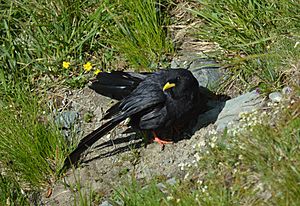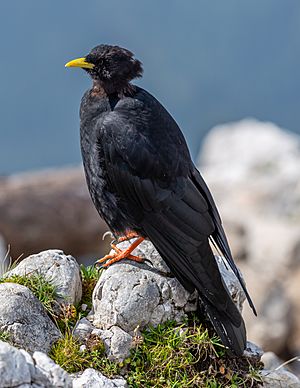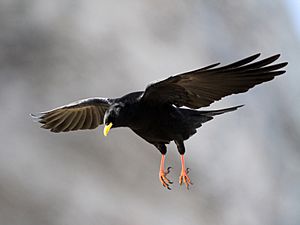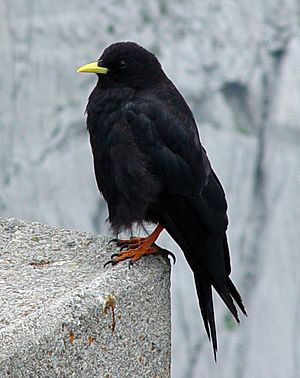Alpine chough facts for kids
Quick facts for kids Alpine chough |
|
|---|---|
 |
|
| Adult of nominate subspecies in Switzerland | |
| Conservation status | |
| Scientific classification | |
| Kingdom: | |
| Phylum: | |
| Class: | |
| Order: | |
| Family: | |
| Genus: |
Pyrrhocorax
|
| Species: |
P. graculus
|
| Binomial name | |
| Pyrrhocorax graculus (Linnaeus, 1766)
|
|
 |
|
| Where alpine choughs live; shown in green | |
The Alpine chough (Pyrrhocorax graculus) is a cool type of bird that belongs to the crow family. It's one of only two species in its group, called Pyrrhocorax. These birds love to build their nests high up in the mountains. You can find them from Spain and Morocco all the way east through southern Europe to the mighty Himalayas.
This bird has shiny black feathers, a bright yellow beak, and red legs. It also has a special call that helps you know it's an Alpine chough! They fly in a fun, acrobatic way, almost like they're dancing in the air. Alpine choughs choose a partner for life and usually return to the same nesting spot each year. Their nests are often in caves or cracks in tall cliffs. They build a cozy nest with sticks and wool, and the female lays about three eggs. These birds often eat together in groups, looking for small creatures like invertebrates in short grassy areas.
Even though bigger birds like the golden eagle sometimes hunt them, the biggest challenge for Alpine choughs is changes in farming. These changes have caused their numbers to drop in Europe. But don't worry, globally, they are not considered an endangered species.
Contents
What the Alpine Chough Looks Like
Adult Alpine choughs have shiny black feathers, a short yellow beak, and red legs. They are a bit smaller than their cousin, the Red-billed Chough. An Alpine chough is about 37–39 cm (14.6–15.4 in) long, with a tail that's 12–14 cm (4.7–5.5 in) long. Their wings can spread out to 75–85 cm (29.5–33.5 in).
Both male and female Alpine choughs look alike, though males are usually a little bigger. Young Alpine choughs are not as shiny as adults. They have a duller beak and brownish legs.
It's hard to confuse the Alpine chough with other birds. Even though the Jackdaw and Red-billed Chough live in the same areas, the Jackdaw is smaller and gray. The Red-billed Chough has a long red beak. When flying, you can tell the two choughs apart because the Alpine chough has less rectangular wings and a longer, less square-shaped tail. Their calls are also very different! The Alpine chough makes a rippling preep and a whistled sweeeooo sound.
Where Alpine Choughs Live
The Alpine chough lives in mountains. You can find them from Spain, across southern Europe and the Alps, through Central Asia, and all the way to the Himalayas in western China. They also live in Morocco, Corsica, and Crete.
These birds usually stay in the same area all year round. They don't migrate (travel long distances) like some other birds. However, some have been seen in places like Czechoslovakia, Gibraltar, Hungary, and Cyprus.
Alpine choughs like to live at high altitudes. In Europe, they usually breed between 1,260–2,880 meters (4,130–9,450 ft) high. In Morocco, they are found even higher, from 2,880–3,900 meters (9,450–12,800 ft). In the Himalayas, they live between 3,500–5,000 meters (11,480–16,400 ft)!
They build their nests in cracks and holes on tall, hard-to-reach rock faces. But they look for food in open areas like meadows and rocky slopes. In winter, they often gather near human places like ski resorts and hotels. They tend to live higher up than the Red-billed Chough.
How Alpine Choughs Behave
Breeding Habits
In the western Italian Alps, Alpine choughs build their nests in many different places. They use natural cliffs, windows of old buildings, and even abandoned buildings. This is different from the Red-billed Chough, which mostly uses natural cliffs.
The Alpine chough starts laying its eggs about a month earlier than its relative. Both species have similar success rates when raising their young. This is probably because the tough mountain environment affects both birds in similar ways.
What They Eat

When Alpine choughs and Red-billed choughs live in the same area, they don't compete much for food. A study in Italy showed that in winter, Red-billed choughs mostly ate a type of plant bulb. Alpine choughs, however, ate berries and rose hips.
In June, Red-billed choughs ate mostly butterfly and moth larvae. Alpine choughs ate pupae (young forms) of craneflies. Later in the summer, Alpine choughs mainly ate grasshoppers. Red-billed choughs added cranefly pupae, fly larvae, and beetles to their diet.
Alpine Chough Status
The Alpine chough lives across a very large area. This area is estimated to be between 1 and 10 million square kilometers (0.4–3.8 million sq mi). There are also many of these birds, with an estimated 260,000 to 620,000 in Europe alone.
Because they have such a wide range and a large population, their numbers are not dropping quickly. The IUCN Red List, which tracks endangered species, says the Alpine chough is of "Least Concern". This means they are not currently threatened with extinction.
About 18,000 years ago, during the last ice age, southern Europe was very cold and open. Alpine choughs lived as far south as Italy back then, which is outside their current home. Some of these ancient groups of birds survived for a long time but disappeared in the last couple of centuries.
For example, in the Polish Tatra Mountains, a group of Alpine choughs had lived there since the ice age. But after the 19th century, they were no longer found breeding there. These local declines are probably not because their homes were completely destroyed. Instead, it might be due to global warming. As the Earth gets warmer, the cool mountain areas these birds prefer might change or even disappear.
Images for kids
-
In-flight in northern Alps, France
-
From North Sikkim, India.
-
Eggs vary from cream to buff to light-green, and have brown speckles.
-
In the Alps, Innsbruck, Austria
See also
 In Spanish: Chova piquigualda para niños
In Spanish: Chova piquigualda para niños











